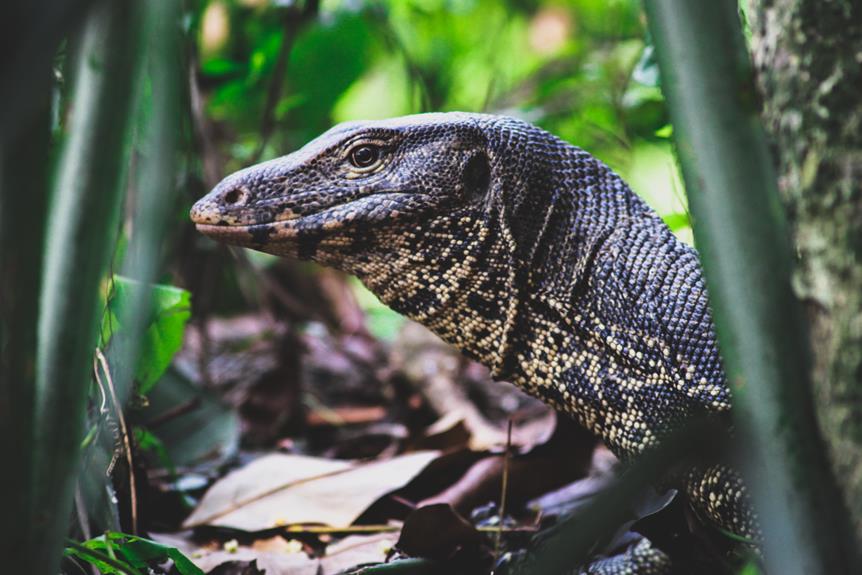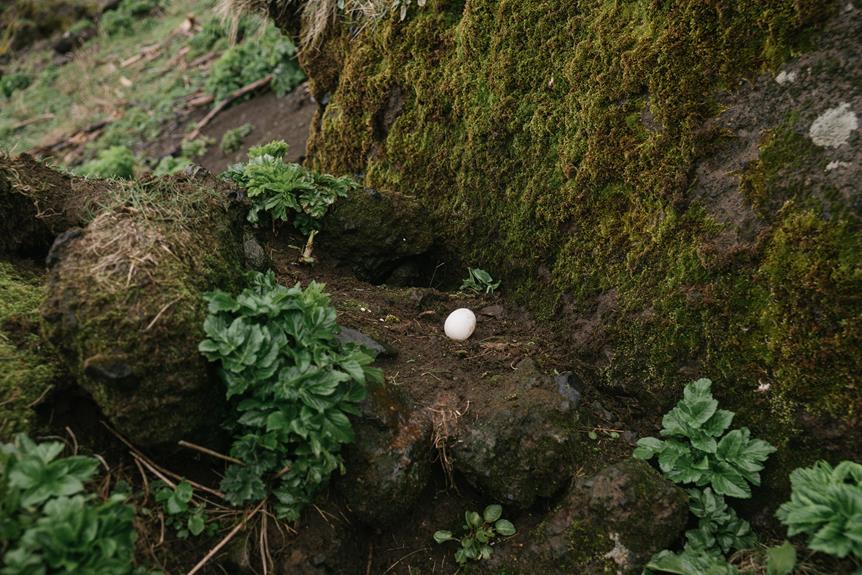Are you ready to dive into the mysterious world of the Komodo dragon?
Get ready to uncover the nesting secrets of the world's largest lizard. From their unique reproduction process to their nesting behaviors, we will explore the intricate details of these fascinating creatures.
Discover the nesting sites, egg-laying habits, and the delicate incubation period of Komodo dragon eggs.
Join us as we unveil the hidden world of parental care and nesting success in these remarkable reptiles.
Key Takeaways
- The breeding season for Komodo dragons occurs between May and August, during which males compete for female attention through combat.
- Female Komodo dragons carefully select and construct nests, laying 20-30 eggs in sandy and well-drained areas. They dig deep holes in the ground to bury their eggs, demonstrating their commitment to safeguarding future generations.
- Nest temperature regulation is crucial for the proper development of the embryos, and environmental factors like temperature and humidity influence nest site selection.
- Nesting sites, such as sandy beaches and volcanic soils, provide optimal conditions for egg incubation and play a role in predator-prey dynamics. Climate change can impact the availability and suitability of nesting sites, affecting the survival and development of the embryos.
The Reproduction Process of the Komodo Dragon
Now let's delve into how Komodo dragons mate and reproduce.
The reproductive cycle of these majestic creatures is a fascinating process to explore. Komodo dragons have specific mating rituals that play a crucial role in their reproductive success.
During the breeding season, which typically occurs between May and August, males engage in fierce competition for the attention of females. They engage in combat, using their powerful tails and sharp claws to establish dominance.
Once a male has successfully courted a female, mating takes place. The female lays her eggs, usually between 20 and 30, in a carefully constructed nest made of vegetation and soil. She then covers the nest and guards it until the eggs hatch, which takes around 7 to 8 months.
Understanding the reproductive cycle and mating rituals of Komodo dragons is essential for conservation efforts and the preservation of these magnificent creatures.
Unveiling the Nesting Behaviors of Komodo Dragons
Observe the meticulous nesting behaviors of Komodo dragons as they carefully construct their nests for the safety of their eggs.
Nesting site selection is a crucial process for these reptiles, as they seek out suitable locations that provide optimal conditions for egg incubation. They often choose sandy and well-drained areas, such as beaches or low-lying savannahs, to create their nests.
To ensure the proper development of their offspring, Komodo dragons also engage in nest temperature regulation. They dig deep holes in the ground, measuring up to 2 meters in diameter, to bury their eggs. By burying the eggs at the right depth, they can protect them from predators and regulate the internal temperature.
The depth of the nest helps maintain a stable temperature, which is vital for the successful incubation of the eggs. Through these nesting behaviors, Komodo dragons demonstrate their commitment to safeguarding their future generations.
The Nesting Sites of Komodo Dragons
Komodo dragons exhibit specific nesting behavior patterns, selecting sites that provide optimal conditions for their eggs. Environmental factors, such as temperature and humidity, play a crucial role in determining the nesting sites. These factors influence the survival and development of the embryos within the eggs.
Additionally, Komodo dragons employ various nest protection strategies to ensure the safety of their eggs. These strategies include burying them deep in the ground or hiding them in dense vegetation.
Nesting Behavior Patterns
You'll be amazed by the variety of nesting sites that Komodo dragons choose to lay their eggs. These large lizards, known for their size and strength, exhibit interesting nesting behavior patterns.
When it comes to selecting a nesting site, Komodo dragons display a preference for sandy beaches, which provide an ideal environment for their eggs. The nesting season timing is crucial for the survival of the Komodo dragon population. They typically lay their eggs between May and August, coinciding with the dry season when the beaches are less prone to erosion and flooding.
During this period, females dig deep holes in the sand to create their nests, ensuring that the eggs are protected from predators and extreme weather conditions. Additionally, the temperature inside the nest plays a vital role in determining the sex of the hatchlings, further influencing the population dynamics of these fascinating creatures.
- Nesting site preference:
- Sandy beaches
- Nesting season timing:
- May to August (dry season)
Environmental Factors Affecting Nesting
Finding suitable nesting sites is crucial for the survival of Komodo dragons. They rely on environmental factors such as temperature and humidity to ensure the successful incubation of their eggs.
The nesting sites of Komodo dragons are carefully chosen based on these factors, as well as other considerations. Climate change, for example, can significantly impact the availability and suitability of nesting sites. Rising temperatures and altered rainfall patterns can affect the temperature and moisture levels within the nest, potentially leading to unsuccessful incubation.
Additionally, predator-prey dynamics play a role in the selection of nesting sites. Komodo dragons prefer to nest in areas with lower predator activity, such as away from other large carnivores or in dense vegetation.
Understanding and protecting these nesting sites is crucial for the conservation of Komodo dragons, especially in the face of ongoing climate change and changing predator-prey dynamics.
Nest Protection Strategies
To ensure the safety of their nests, Komodo dragons employ various protection strategies, such as burying their eggs deep within the ground or hiding them amidst dense vegetation. Nesting site selection is crucial for the survival of the offspring, as it determines the level of protection from predators and environmental conditions.
Komodo dragons exhibit a remarkable ability to choose nesting sites that offer optimal conditions for their eggs. They often select areas with loose soil, which facilitates digging and burying the eggs at a sufficient depth. This depth provides insulation against temperature fluctuations and protects the eggs from predators.
Additionally, Komodo dragons use nest construction techniques, such as compacting the soil above the eggs, to create a secure and well-hidden nest. These strategies ensure the survival of the next generation of Komodo dragons in a challenging and competitive environment.
Egg-laying Habits of the World's Largest Lizard
During the breeding season, female Komodo dragons carefully select a suitable nesting site for their eggs. The reproductive cycle of Komodo dragons consists of a mating period followed by egg-laying.
After successful mating, the female Komodo dragon embarks on a quest to find the perfect spot to deposit her eggs. She seeks out a site that's well-drained, secluded, and provides optimal conditions for incubation. The nesting site selection process is crucial for the survival of the eggs, as it determines their chances of hatching successfully.
Female Komodo dragons display a remarkable sense of instinct and knowledge when choosing a suitable location. They often prefer sandy beaches or volcanic soils, where the eggs can be buried deep enough to protect them from predators and regulate temperature.
The careful selection of nesting sites ensures the continuation of the Komodo dragon population.
Incubation Period and Hatching of Komodo Dragon Eggs
After approximately 7-8 months of incubation, the Komodo dragon eggs hatch, and the newborns emerge from their underground nests. The incubation duration plays a crucial role in the hatching success of the eggs.
Here are some key points to emphasize:
- Optimal conditions: The eggs require a constant temperature of about 88-92°F (31-33°C) during incubation.
- Importance of heat: The heat allows for proper development of the embryos and speeds up their metabolism.
- Nest selection: The female Komodo dragons carefully choose warm, well-drained soil to create their nests, ensuring suitable conditions for successful incubation.
The hatching success of Komodo dragon eggs is influenced by various factors, including temperature, humidity, and nest site selection. Understanding these factors is essential for conserving this endangered species.
Now, let's delve into the next section, which explores the fascinating topic of parental care and nesting success of Komodo dragons.
Parental Care and Nesting Success of Komodo Dragons
You frequently witness Komodo dragons displaying exceptional parental care, ensuring the nesting success of their offspring. Nesting behavior studies have revealed that female Komodo dragons invest significant effort in selecting an appropriate nesting site and creating a suitable nest environment. They carefully dig deep burrows to protect their eggs from predators and extreme temperatures, providing a safe and stable environment for incubation.
This parental investment greatly enhances the chances of successful hatching and survival of the offspring. Furthermore, the female Komodo dragons exhibit a remarkable form of parental care by guarding the nests during the incubation period. They remain vigilant, protecting the eggs from potential threats, such as predators or disturbances.
This level of dedication and commitment ensures high nesting success rates among Komodo dragons and highlights their remarkable reproductive strategies.
Frequently Asked Questions
How Long Does It Take for Komodo Dragon Eggs to Hatch?
Komodo dragon eggs typically take around 7-8 months to hatch. The nesting habits of Komodo dragons involve digging burrows and laying their eggs in sandy soil. Optimal incubation conditions include proper temperature and humidity levels.
Do Komodo Dragons Build Their Nests in the Same Location Every Year?
Komodo dragons exhibit interesting nesting behavior. They carefully select their nest sites each year, but whether they use the same location or not is not yet fully understood. Further research is needed to determine their nesting site preferences.
How Many Eggs Does a Female Komodo Dragon Typically Lay in One Nesting Season?
A female Komodo dragon typically lays around 20 eggs in one nesting season. The nesting success is determined by various factors, including the incubation period, which lasts for about 7-8 months.
Are Male Komodo Dragons Involved in the Nesting Process?
Male Komodo dragons do not participate in the nesting process. Females undergo hormonal changes during nesting, which involves digging a hole, laying eggs, and burying them. Males are not involved in incubation or caring for the offspring.
What Factors Contribute to the Nesting Success of Komodo Dragons?
Factors such as temperature, humidity, and nesting site selection greatly influence the nesting success of Komodo dragons. The environmental conditions during the nesting process play a crucial role in ensuring the survival of their offspring.
Conclusion
In conclusion, the nesting secrets of the world's largest lizard, the Komodo dragon, have been unveiled. Through careful observation and analysis, scientists have discovered the intricate reproduction process, nesting behaviors, and egg-laying habits of these majestic creatures.
The incubation period and hatching of Komodo dragon eggs have also been examined, shedding light on their fascinating life cycle. Furthermore, parental care plays a crucial role in the nesting success of these remarkable reptiles.
Uncovering these secrets has provided invaluable insights into the world of the Komodo dragon, leaving us in awe of nature's wonders. Like a hidden treasure, the nesting secrets of the Komodo dragon have been revealed, unlocking a wealth of knowledge about this remarkable species.



